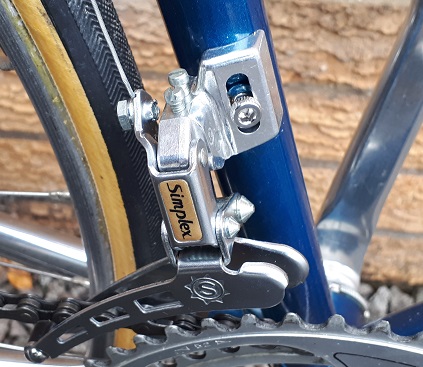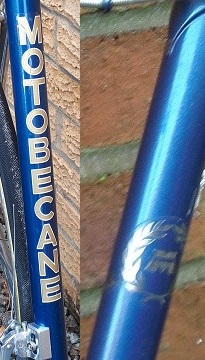NOTE: This article is specifically about the top level Motobecane racing bikes variously known as Equipe Pro, Team Champion, and of course the La Redoute team bikes. These are the dark blue and chrome bikes that are well known to followers of the brand and students of bicycle racing in the 1980s.
I am currently building up a Motobecane Team Champion frame as a team replica bike and to ensure accuracy I have checked out as many racing photos and brochures as I can find on the internet. The main differences that I can find are: Front Derailleur attachment; Rear Brake Cable routing: Rear Dropouts; Chrome plated areas; Seat Tube Decals; and Fork Crowns. Not surprisingly, I am seeing the same changes on production bikes as on team bikes – which supports the catalogue statement that they are built in the same artisanal workshop. My guess, and it is a guess, is that the changes made to production bikes that I haven’t seen on team bikes were made after the last season of the La Redoute – Motobecane Team in 1984. I am going to refer to these bikes that differ from the team bikes as “post 1984” until or unless I ever know better, even though they appear on the internet with earlier dates, I believe that to be inaccurate.
Front Derailleur
The first Motobecane team bikes used clamp on Simplex SLJ front derailleurs, then about 1982 they changed to a fitting that I think was unique to Simplex with a single brazed boss on the down tube to take a derailleur attaching screw. This is a neater arrangement than the brazed-on tab used by other manufacturers. I do not know enough about Simplex front derailleurs to know whether the post-1984 bikes used the same front derailleur as the team and team replica bikes.

Rear Brake Cable Routing
The first bikes from 1980 had brake cable eyes on the top of the top tube. Then, I think again about 1982, they used a routing system that I have not seen before or since. The top tube was formed with a groove into which the cable is pressed, There is a cable eye front and rear to make sure the cable is not pulled out of the groove. Making the frame tube like that would, in theory, reduce torsional stiffness, but presumably not enough to cause any concern. Post-1984 frames tend to keep this later routing.

Chrome Plating
The team bikes without exception have a fully plated rear triangle as well as a full chrome fork. I have seen statements indicating that the plated rear triangle was an option on the team replica Motobecane Equipe Pro and Team Champion bikes but I have never seen one without. On the other hand I have only seen post-1984 frames with no rear chrome, just the chrome fork (see the bike on this website as an example)
Rear Dropouts
As far as I can make out the team bikes from 1980 to 1984 had Simplex rear dropouts – the sort with the small round plastic “nut” for the adjuster screw and the replica bikes sold to customers as Equipe Pro or Team Champion were the same. Whereas I am seeing different dropouts on the post-1984 bikes
Rear Derailleur Cable Routing
My research indicates that the 1980-84 team bikes and replicas all had the rear derailleur cable routed under the bottom bracket, whereas I have seen post-1984 models with over bottom bracket cable runs as well as under.
Fork Crown
The Motobecane – La Redoute team and replica bikes have a Cinelli microfusion Fork Crown that blends seamlessly into the fork blades. The post-1984 bikes have a more conventional fork crown as shown on the right of the attached picture, with the Cinelli crown on the left

Seat Tube Decals
The team and team replica frames, 1980-84, have “MOTOBECANE” lettering vertically on the centre front of the seat tube, where it appears best in racing action photographs. The post-1984 frames in contrast do not have this decal but instead a crest each side consisting of the Motobecane stylised “M” inside a wreath

Rear Derailleurs
The Motobecane team and team replica bikes are fitted with the Simplex SLJ 6600 rear derailleur. The post-1984 bike on this website uses a Simplex SX610 derailleur which looks superficially similar, but is cheaper.
Crankset
The 1980-84 La Redoute team and replica bicycles all used Stronglight 107 cranksets. I don’t have a record of what was fitted to the post-1984 bike on this website, but it isn’t a 107. It looks like it could be a model 106. Photos that I can find of similar post-1984 bikes show the same crankset.
Brakes
The team and team replica bikes all had Weinmann Carrera 400 brakes. The post-1984 bike on this website has Weinmann 405 brakes. I cannot tell what brakes are on the other similar bikes I see on the internet.
Handlebars and Stem
Team spec was Cinelli 1R stem and Cinelli Giro d’Italia bars as standard but some team riders preferred Criterium bars judging from race photographs. The Criterium bars were generally preferred by sprinters because of the greater arm clearance they provide as the bike is heaved from side to side in a sprint. Many post-1984 bikes have Philippe stem and bars with the patented one piece covering as on the bike on this website.
Number Tab
All the Motobecane La Redoute team bikes and replicas have a number tab fo a racing number under the top tube, None of the post-1984 Equipe Pro and Team Champion bikes that I have seen have a number tab.
Conclusion
The bikes that I have designated “post-1984”, although quality racing bikes, are clearly a bit cheaper to produce than the bikes of the Motobecane – La Redoute team and the replicas sold to the public under the model names “Equipe Pro” and “Team Champion”. I am confident in proclaiming that they were made subsequent to the team replica bikes because they carried the same model names and were not shown in the 1980 – 1984 catalogues. The primary differentiators would be the rear triangle chrome, the rear dropouts and the seat tube decals. The other equipment is easily changed. Motobecane paint quality was good and durable, so it is not likely that many will have been refinished, though very good replica decals are readily available from Bicycle Decals.
